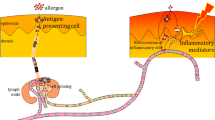Abstract.
We have investigated the cytokine response pattern following sensitisation (induction) of BALB/c mice with different chemicals (dinitrochlorobenzene, dinitrofluorobenzene, oxazolone, glutaraldehyde, formaldehyde, trimellitic anhydride, croton oil) and elicitation (challenge) of contact allergy in sensitised animals. The results of our investigations showed that different chemicals induced both T helper (Th) 1 cytokines [interleukin (IL) 2, interferon β (IFNβ)] and Th2 cytokines (IL-4, IL-10) at different stages during murine contact allergy. We also confirmed our previous findings that IL-4 and IL-10 release were up-regulated during the challenge phase regardless the contact allergen used, whereas the release of IFNβ did not show a clear preference for being up- or down-regulated. In our hands, the increased expression of Th2 cytokines after challenge exposure to contact allergens appeared as a stable marker of secondary contact allergenic responses. Quantitative differences in the expression of IL-4 were observed between different contact allergens. The present results clearly indicate that skin sensitisers were able to elicit cytokine response patterns, which could not be related to a clear-cut Th1 or Th2 type of cytokine response. Furthermore, dermal application of contact allergens produced different kinetics of cytokine secretion upon induction and challenge. In our hands, the co-expression of Th1 and Th2 type cytokines appeared as a universal consequence of dermal application of contact allergens to responsive mice. Our results indicate that co-expression of Th1 and Th2 cytokines during contact allergy is an important feature of murine contact allergy in responsive mice and that chemicals differ in their potency to induce the expression of these cytokines. Furthermore, the results do not support the view that different chemicals induce Th1 or Th2 cytokines in a mutually exclusive manner depending on their preference for inducing either contact or respiratory allergy. The results are expected to renew the discussion about the usefulness of the Th1/Th2 paradigm in certain areas of immunotoxicology.
Similar content being viewed by others
Author information
Authors and Affiliations
Additional information
Electronic Publication
An erratum to this article is available at http://dx.doi.org/10.1007/s00204-002-0332-z.
Rights and permissions
About this article
Cite this article
Ulrich, .P., Grenet, .O., Bluemel, .J. et al. Cytokine expression profiles during murine contact allergy: T helper 2 cytokines are expressed irrespective of the type of contact allergen. Arch Toxicol 75, 470–479 (2001). https://doi.org/10.1007/s002040100267
Received:
Accepted:
Issue Date:
DOI: https://doi.org/10.1007/s002040100267




